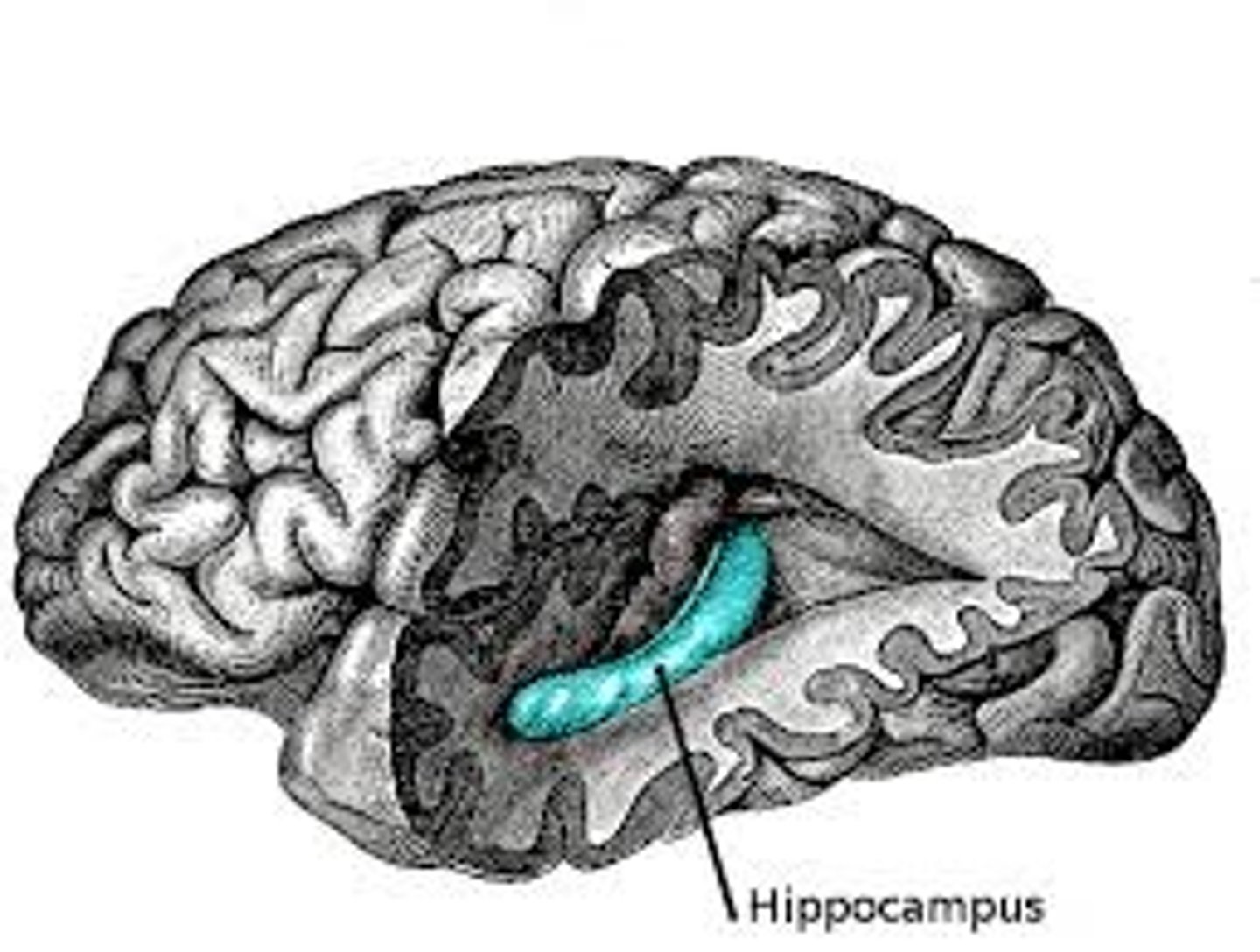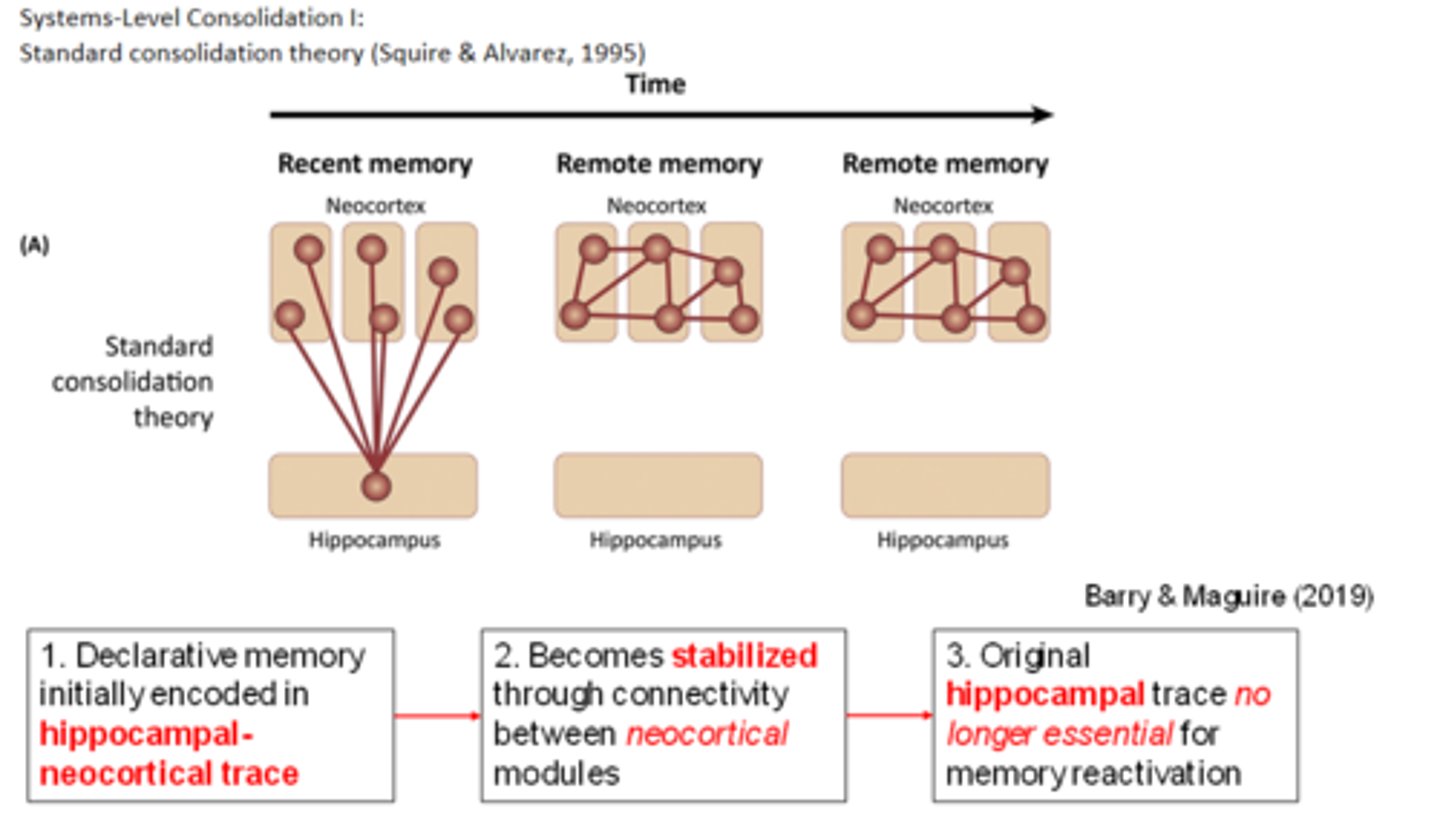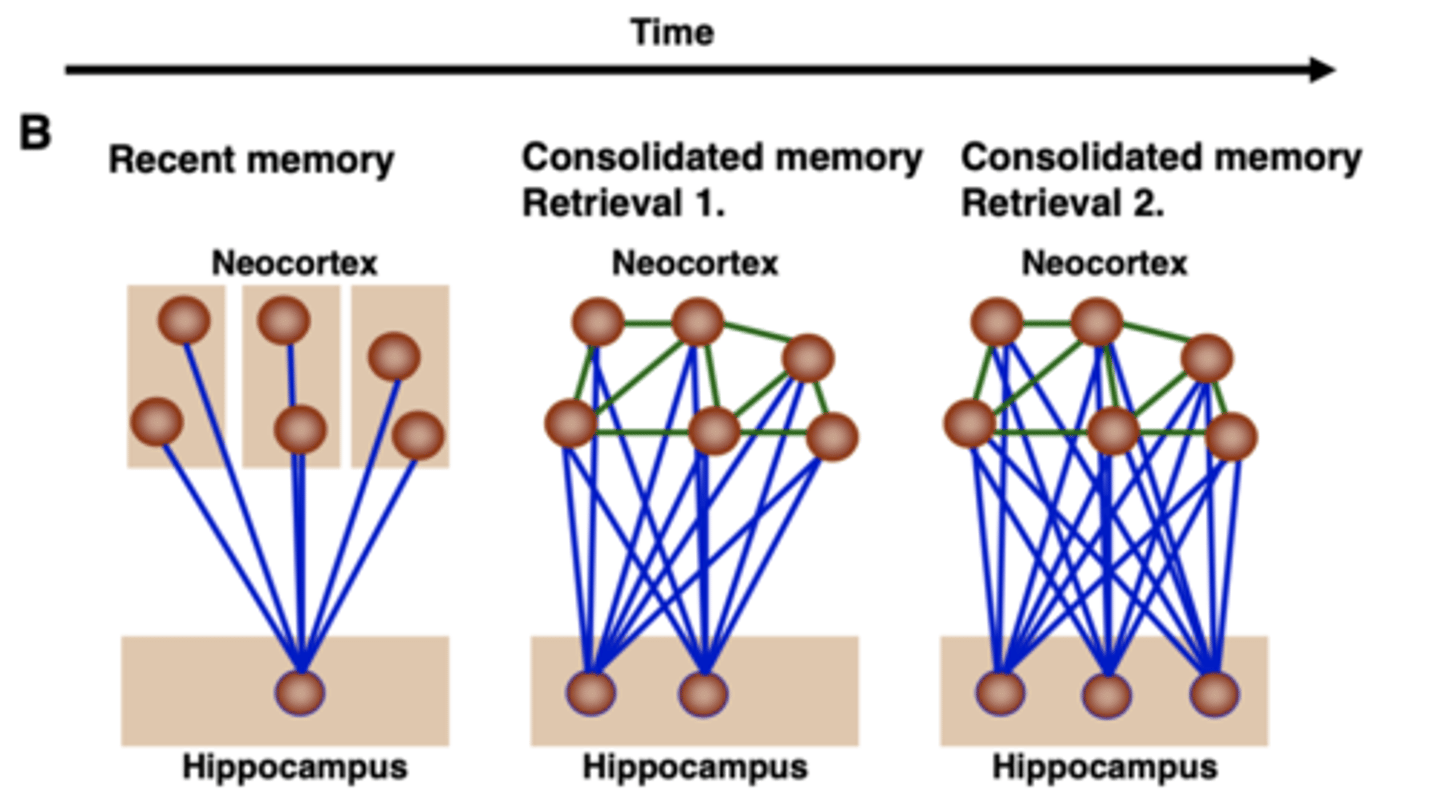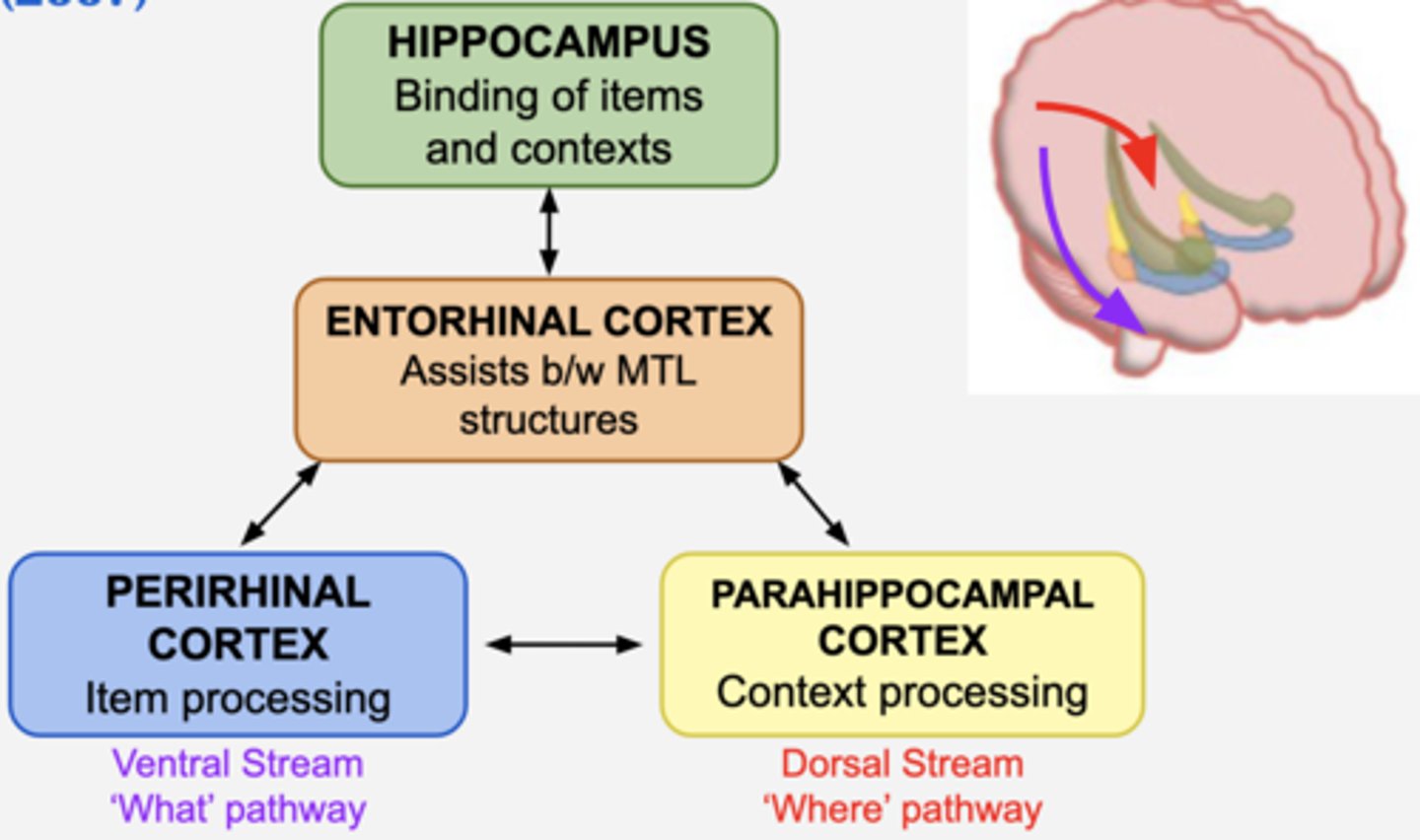PSYC327: Long-Term Memory
1/37
There's no tags or description
Looks like no tags are added yet.
Name | Mastery | Learn | Test | Matching | Spaced |
|---|
No study sessions yet.
38 Terms
The Hippocampus
involved in memory; tucked deep inside the temporal lobes on the left and right

Medial Temporal Memory System (MTS)
hippocampus + Surrounding Cortex + Subcortical Structures
Other Structures Involved in Memory
The Parahippocampal, perirhinal and entorhinal cortices
- they "wrap around" the hippocampus
Two Subcortical Structures for Memory
fornix & mammillary body
- Damage to either of these structures result in severe and profound long-term memory losses
Damage to MTS
Medial Temporal Amnesia
Medial Temporal Amnesia
memory disorder primarily caused by damage to the medial temporal lobe structures, especially the hippocampus, which leads to difficulties forming new memories (anterograde amnesia) and recalling old ones (retrograde amnesia).
- Onset is cumulative
Patient HM & Medial Temporal Amnesia
after removal of the medial portions of the temporal lobes (including the hippocampus), H.M. became profoundly amnesic
- Tissue where the hippocampus lies was completely removed
- Amnesia due to the MTS & Hippocampus
Causes of Medial Temporal Amnesia
- Surgery (HM)
- Infection (e.g., herpes simplex encephalitis: Clive Wearing)
- Hypoxia (e.g., carbon monoxide poisoning)
- Alzheimer's (most common cause)
- Korsakoff's (damage to mammillary bodies from a deficit in b vitamin)
Medial Temporal Amnesia: Two Components
1. Loss of memories for at least 1 yr before illness (retrograde amnesia)
2. Cannot remember new facts/events (anterograde amnesia)
Retrograde Component: Features
- memory disorder characterized by the inability to recall events, information, or experiences that occurred before the onset of the amnesia.
- impaired period at least 1 yr
- pattern may be more continuous (shows a temporal gradient)
- Memory for semantic facts learned before illness may be large sparedAnterograde Component: Features
Measuring Retrograde Amnesia: H.M.
- Corkin and colleagues gave H.M. a series of cue words (e.g. holiday, friend), and asked him to recall a personal experience connected with each one.
- On this test, all of H.M.'s spontaneous recollections were from events occurring prior to his 16th birthday - even though he did not undergo surgery until age 27
- demonstrates some memory from before illness remained
Retrograde Component: Tests
- Giving a series of cues words
- Autobiographical Memory Interview
Limitation of Giving a Series of Cued Words
cannot control the period
- Patient may prefer a different period and discusses that instead
Autobiographical Memory Interview
- Askes questions/cued recall of experiences from three time periods: Childhood, Early adult life and Recent events
- Probe the pp to provide as many details about the event as possible
- Analyse whether they were able to come up with an event and extra points on if they had internal details of the eve
Anterograde Component: Features
- Much more profound and severely impaired
- Knowledge and personal history can be "frozen in time"
- Patients have a short "window" of recall before memory is lost
- Both episodic and semantic memory are affected BUT a tiny bit of semantic learning can occur, even in the most severe cases.
Anterograde Components: Tests
- Free recall
- Recongition
- Paired Associate Learning
Free Recall
ask pp to report back what words were presented a few minutes prior
Recognition
Giving a series of items (e.g., faces) -> 5-15 min break -> give more items -> ask whether they saw it prior e.g.,
Paired Associate Learning
two words presented as a pair -> give them one word and ask them to recall the word paired with it
- Most difficult and highly sensitive
Function of MTS
MTS - specifically hippocampus - appears critical for learning associations that occurred on a single occasion
Consolidation Theory (Alvarez & Squire, 1995)
All aspects of an experience cause changes in the relevant cortical areas. The MTS (/Hippocampus) c takes one of changes during an experience and forms new connections between itself and these cortical areas. This leads to activation of one component spreading throughout the network and it allows you to experience an entire experience from one trigger

Process of Consolidation
1. You need the Hippocampus to retrieve the memory (period before damage where hippocampus is still healthy). Memory is laid down accurately
2. But, repeated recollection (via reminiscing, talking to others, photos etc.) strengthens direct cortico-cortical connections
3. Eventually, can recall entire experience without hippocampus
Retrograde Amnesia & Consolidation Theory: Reason for Temporal Gradient
Process takes time, meaning events 1-3 years prior to onset of illness is unable to be remembered (hasn't had time for recent memories to recollect them and remember them enough to develop these connections)
Strengths of Consolidation Theory & Retrograde Amnesia
- Makes sense of the temporal gradient
- Explains why people with amnesia can't encode new memories (Need hippocampus for initial step to occur; without it, the other stages cannot occur)
Limitations of Consolidation Theory & Retrograde Amnesia
Is the memory really the same after we have repeatedly recalled it? ...or does it change in some important way?
- memories are sparce
- 90%ish is not recollected on or reminisced
- Our memory is always changing and contorting as a result of recollection
Multiple Trace Theory (Nadel & Moscovitch)
Each time you recall a memory, you create a new memory (trace) of the recollection of the event itself and repeated recall doesn't just strengthen the cortical connections and instead make new traces/changes the nature of the memory

Evidence Supporting Multiple Trace Theory
- Found that healthy people are bad at remembering details from earlier memories compared to recent memories
- Found that people with temporal amnesia had the same inability to remember childhood memories but their level of detail is still low for recent memories
Strengths of Multiple Trace Theory
- How semantic memories develop
- why remote memories are so fragmented
- Why we sometimes misremember thing
Hippocampus
linking/binding elements together that occurred during a single event to make up a single memory
- Measuring this is paired associate task
Other structures that work with the hippocampus
- Parahippocampal Gyrus =
- Entorhinal Cortex
- Perirhinal Cortex = remembering elements and items
The Perirhinal Cortex
remembering elements and items
The Parahippocampal Cortex
coding the background scenes and settings/context
The Parahippocampal Cortex: Neuropsychology Evidence
Case of GR: had damage to Parahippocampal cortex but not hippocampus and was unable to navigate new environments
Demonstrates that navigating in unfamiliar environments is a central role of the Parahippocampal cortex
Eichenbaum: Binding in Context (BIC) Model

semantic dementia
Memory for facts more impaired than events
The earlier the memory was learned, the more likely it is to be affected
Semantic Dementia: Brain Damage
Lateral Temporal Lobes
Semantic Dementia: Assessing Knowledge Loss
- Picture Naming
- Drawing from Memory
- Picture-to-Picture Matching Tasks
The Hub-and-Spoke Model
A model of semantic knowledge that proposes that areas of the brain that are associated with different functions are connected to the anterior temporal lobe, which integrates information from these areas.
Language + auditory + visual + olfactory + motor praxis + somatosensory = extract our core common to the experience and tip of temporal lobe creates an abstract storage for it